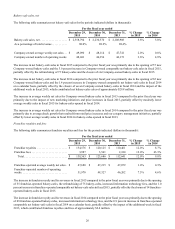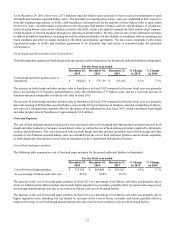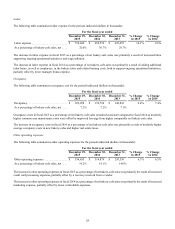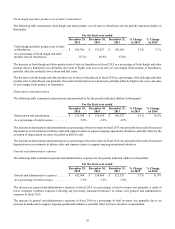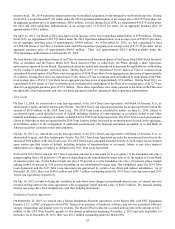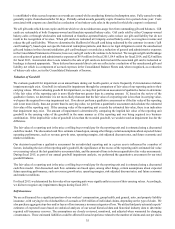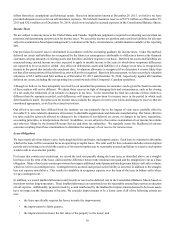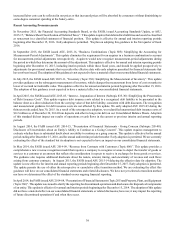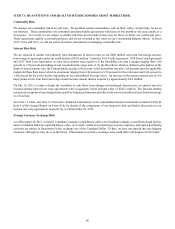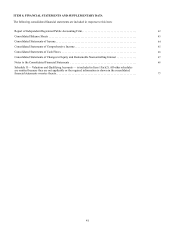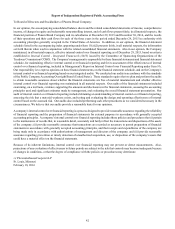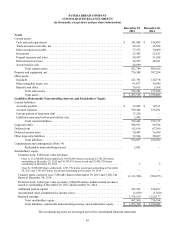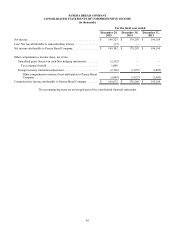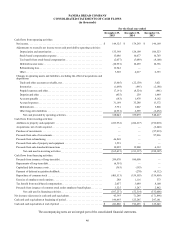Panera Bread 2015 Annual Report Download - page 46
Download and view the complete annual report
Please find page 46 of the 2015 Panera Bread annual report below. You can navigate through the pages in the report by either clicking on the pages listed below, or by using the keyword search tool below to find specific information within the annual report.36
differs from these assumptions and historical trends. Based on information known at December 29, 2015, we believe we have
provided adequate reserves for our self-insurance exposure. We held self-insurance reserves of $37.2 million as of December 29,
2015 and $32.6 million as of December 30, 2014, which were included in accrued expenses in the Consolidated Balance Sheets.
Income Taxes
We are subject to income taxes in the United States and Canada. Significant judgment is required in evaluating our uncertain tax
positions and determining our provision for income taxes. We assess the income tax position and record the liabilities for all years
subject to examination based upon management’s evaluation of the facts, circumstances, and information available at the reporting
date.
Our provision for income taxes is determined in accordance with the accounting guidance for income taxes. Under this method,
deferred tax assets and liabilities are recognized for the future tax consequences attributable to differences between the financial
statement carrying amounts of existing assets and liabilities and their respective tax basis. Deferred tax assets and liabilities are
measured using enacted income tax rates expected to apply to taxable income in the years in which those temporary differences
are expected to be recovered or settled. Any effect on deferred tax assets and liabilities of a change in tax rates is recognized in
income in the period that includes the enactment date. A valuation allowance is recognized if we determine it is more likely than
not that all or some portion of the deferred tax asset will not be recognized. Based on this assessment, we have recorded a valuation
allowance of $5.3 million and $4.6 million as of December 29, 2015 and December 30, 2014, respectively, against all Canadian
deferred tax assets, including the net operating loss carryforwards of the Company's Canadian operations.
Although we believe we have adequately reserved for our uncertain tax positions, no assurance can be given the final tax outcome
of these matters will not be different. We adjust these reserves in light of changing facts and circumstances, such as the closing
of a tax audit, the refinement of an estimate or changes in tax laws. To the extent that the final tax outcome of these matters is
different than the amounts recorded, such differences will impact our provision for income taxes in the period in which such
determination is made. Our provision for income taxes includes the impact of reserve provisions and changes to reserves that are
considered appropriate, as well as the related net interest.
Our effective tax rates have differed from the statutory tax rate primarily due to the impact of state taxes, partially offset by
favorable U.S. rules related to donations of inventory to charitable organizations and domestic manufacturing. Our future effective
tax rates could be adversely affected by changes in the valuation of our deferred tax assets, or changes in tax laws, regulations,
accounting principles, or interpretations thereof. In addition, we are subject to the routine examination of our income tax returns
and other tax filings by the Internal Revenue Service and other tax authorities. We regularly assess the likelihood of adverse
outcomes resulting from these examinations to determine the adequacy of our reserve for income taxes.
Lease Obligations
We lease nearly all of our bakery-cafes, fresh dough facilities and trucks, and support centers. Each lease is evaluated to determine
whether the lease will be accounted for as an operating or capital lease. The term used for this evaluation includes renewal option
periods only in instances in which the exercise of the renewal option can be reasonably assured and failure to exercise such option
would result in an economic penalty.
For leases that contain rent escalations, we record the total rent payable during the lease term, as described above, on a straight-
line basis over the term of the lease, and record the difference between the minimum rent paid and the straight-line rent as a lease
obligation. Many of our leases contain provisions that require additional rental payments based upon net bakery-cafe sales volume,
which we refer to as contingent rent. Contingent rent is accrued each period as the liability is incurred, in addition to the straight-
line rent expense noted above. This results in variability in occupancy expense over the term of the lease in bakery-cafes where
we pay contingent rent.
In addition, we record landlord allowances and incentives received as deferred rent in the Consolidated Balance Sheets based on
their short-term or long-term nature. These landlord allowances are amortized over the reasonably assured lease term as a reduction
of rent expense. Additionally, payments made by us and reimbursed by the landlord for improvements deemed to be lessor assets
have no impact on the Statements of Income. We consider improvements to be a lessor asset if all of the following criteria are
met:
• the lease specifically requires the lessee to make the improvement;
• the improvement is fairly generic;
• the improvement increases the fair value of the property to the lessor; and


